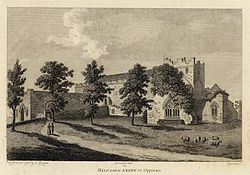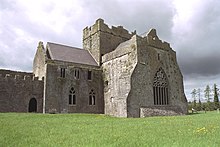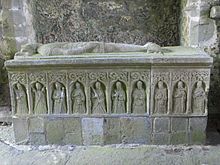Kilcooly Abbey
| Kilcooly Cistercian Abbey | |
|---|---|
 View of the abbey in 1786 |
|
| location |
County Tipperary |
| Coordinates: | 52 ° 40 '14.7 " N , 7 ° 34' 16.5" W |
| Serial number according to Janauschek |
469 |
| Patronage | St. Mary St. Benedict |
| founding year | 1184 |
| Year of dissolution / annulment |
1540 |
| Mother monastery | Jerpoint Abbey |
| Primary Abbey | Clairvaux Monastery |
|
Daughter monasteries |
no |
Kilcooly Abbey ( Irish Cill Chúile ; Arvus Campus) is a former Cistercian abbey in County Tipperary in what is now the Republic of Ireland. It is located in the parish of Kilcooly in the middle of a flat plain.
history
The monastery was founded in 1182 by Donal Mór O'Brien, King of Thormond , and in 1184 it was subordinated to the Jerpoint Monastery . It thus belonged to the filiation of the Clairvaux Primary Abbey . In 1228 Stephan von Lexington deposed the abbot as a visitor. In 1418 the monastery was damaged by fire and almost completely destroyed in armed conflict in 1448. Around 1500 a tower was built over the south transept of the church. When it was dissolved in 1540, the monastery only had two monks. After the dissolution, James Butler, the Earl of Ormond, received the monastery property. The monks are said to have returned for a short time in 1640. Towards the end of the 18th century, Sir William Barke built a winged house to the east of the monastery, which was destroyed by fire in 1840. A summer house was then built in the ruins of the abbey, which was still in use in the first half of the 20th century.
Buildings and plant
The church, which was renovated in the 15th century, has largely been preserved, in particular the presbytery, the arches of the crossing tower, the transept, the north wing of which is still vaulted, two sediles and the sacristy. The longhouse has lost its roof. The cloister buildings were heavily changed after 1540. The Protestant church in the northeast takes the place of the former gate chapel . Several grave monuments and figural jewelry as well as the pigeon house have also been preserved. As in Jerpoint Abbey, some of the remarkable sculptures come from Rory O'Tunney, for example the tomb of Pierce fitzOge Butler from 1526 with his armored reclining figure and ten apostle figures arranged on the side.
literature
- Wolfgang Metternich: Art monuments in Ireland . Darmstadt: Wissenschaftliche Buchgesellschaft, 2003, p. 155, ISBN 978-3-534-14909-4
- L. Russell Muirhead (Ed.): Ireland , The Blue Guides, London: Ernest Benn Ltd., 1962, p. 208, without ISBN.

